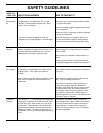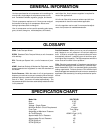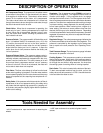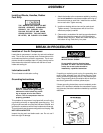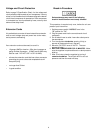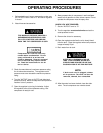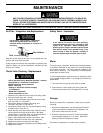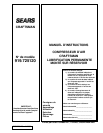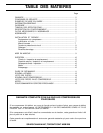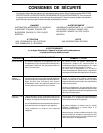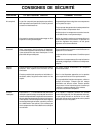
11
TROUBLESHOOTING GUIDE
PROBLEM
CAUSE
Excessive tank pressure - safety
valve pops off.
Air leaks at fittings or hose.
Air leaks at pressure switch
release valve.
Air leaks in air tank or at air tank
welds.
Air leaks between head and valve
plate.
Pressure reading on the regu-
lated pressure gauge drops when
an accessory is used.
Air leak from safety valve.
Knocking noise
Move the pressure switch lever to the “O”
position. If the compressor doesn’t shut off,
disconnect from the electrical outlet source
and return to a Sears Service Center to re-
place the pressure switch.
Return the compressor to Sears Service Cen-
ter to check and adjust, or replace switch.
Tighten fittings using teflon tape where air
can be heard escaping. Check fittings with
soapy water solution. DO NOT OVER-
TIGHTEN.
Return to Sears Service Center for replace-
ment of pressure switch.
Check to see if the pin in the bottom of the
pressure release valve is stuck. If it does not
move freely, return to the Service Center for
replacement of pressure switch.
A defective check valve results in a constant
air leak at the pressure release valve when
there is pressure in the tank and the com-
pressor is shut off. Remove and clean or re-
place check valve. DO NOT OVERTIGHTEN.
Air tank must be replaced. Do not repair the
leak. Return compressor to Sears Service
Center.
Torque head screws to 7-10 ft. lbs. If this
does not stop leak, replace seal.
If there is an excessive amount of pressure
drop when the accessory is used, adjust the
regulator.
NOTE
Adjust the regulated pressure under flow
conditions (while accessory is being used).
Operate safety valve manually by pulling
on ring. If valve still leaks, it should be
replaced .
Remove and clean, or replace.
CORRECTION
Pressure switch does not shut off
motor when compressor reaches
cut-out pressure.
Pressure switch cut-out too high.
Tube or hose fittings are not tight
enough.
Defective pressure switch release valve.
Defective or dirty check valve.
Defective air tank.
Leaking seal.
It is normal for some pressure drop
to occur.
Possible defect in safety valve.
Defective check valve.
DO NOT DRILL INTO, WELD OR OTHER-
WISE MODIFY AIR TANK OR IT WILL
WEAKEN. THE TANK CAN RUPTURE OR
EXPLODE.
PERFORMING REPAIRS MAY EXPOSE VOLTAGE SOURCES, MOVING PARTS OR COMPRESSED AIR
SOURCES. PERSONAL INJURY MAY OCCUR. PRIOR TO ATTEMPTING ANY REPAIRS, UNPLUG THE COM-
PRESSOR AND BLEED OFF TANK AIR PRESSURE.




